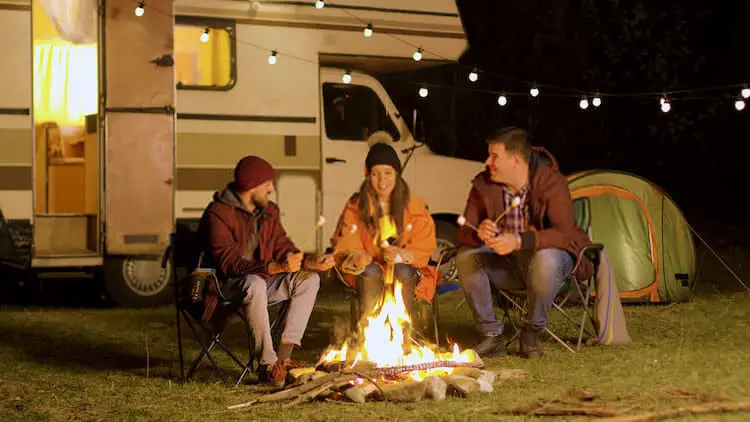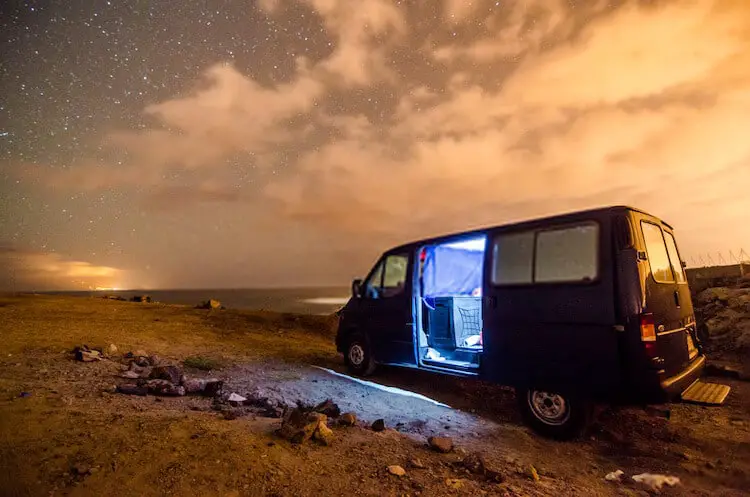Published Date: July 22, 2020
Last Updated on October 23, 2022 by camper front
If you are not willing to run the risk of draining your battery and getting stuck in the middle of nowhere while boondocking, then you should learn how to heat a camper without electricity.
It is imperative, since most heaters need electricity to run, relying solely on these may result in expensive waste and the danger of Carbon monoxide.
Therefore, I’m going to show you a preferable option that keeps you warm safely, while conserving your fuel for the journey ahead.
Table of Contents
Why Should You Heat Your Camper Without Electricity?

Before proceeding, there is a common misconception that keeping your RV or camper toasty warm without the use of electricity is deceitful.
Well, it’s the opposite.
No doubt: thousands of champers have been using a propane heaters, furnaces, and other accessories that operate on electricity to stay warm at night.
But, let’s face it: these heat sources may provide a warm, comfortable environment for your RV. However, they take a big bite from your budget.
Furthermore, most of these heat sources are for outdoor use only, for instance, tank-top heaters. NEVER use your propane oven or stovetop burner inside your camper, it is NOT SAFE.
Here’s proof:
According to CDC research on the:
They further went on to explain that: “Inside a tent or camper, these sources produce dangerous concentrations of CO, which becomes even more dangerous to sleeping persons who are unable to recognize the early symptoms of CO poisoning.”
People die every year because they try to heat their RV this way.
Aside from the annual average fatal CO deaths inside tents and campers, there are other disadvantages of using gas furnaces and other heaters in your living space.
For example, fuel burns quickly (fuel is expensive), the blower can be noisy (creates discomfort), the fan runs off of battery power, and it’s not effective (inability to zone heat without multiple sources).
Although, you may be familiar with these heaters. But other available alternatives can help you stay warm and cozy in your camper even in cold climes, without putting your health on the line, or having to burn expensive and fume-emitting propane.
They are externally vented, cheaper, more efficient to run, eco-friendly, great for boondocking, and are common among RVers.
So, without further ado, if you have been wondering how to heat a pop-up camper without electricity and asking the question, “how can I heat my camper without electricity,” below is how to do it painlessly.
How To Heat A Camper Without Electricity
Having told you why heating your camper without electricity is the best and safest way to do it, here’s how to heat a camper without electricity:
Heat the Camper with Wood Stove
While it is not safe to accommodate a full-sized fireplace in your camper, it is not an excuse to give up on the idea of wood-burning as a source of warmth either.
The wood stove is a better alternative – a much smaller version of a fireplace. The wood stove comes in different sizes. Some are portable stoves and easy to transport.
You can set them on a shelf, mount them on the floor, or even the wall, which makes them perfect for your living space where open fires are not permitted.
Yeah Yeah, I know you are probably thinking about the smoking inconvenience. But, the wood stove creates a minimum amount of smoke due to its secondary combustion system.
It comes with a stovepipe vent, often with interlocking flue pipe sections that can channel the smoke outside.
More importantly, it is best than an open fire and much safer than a diesel heater or propane cook stove.
According to the Cubic Mine stove:
Putting it all together, you can keep warm on the road and never worry about how the weather might affect your destination or comfort.
You can heat your shelter safely, dry your gear, and warm your hand and feet on a cold winter’s night, making it an excellent choice for campers, hunters, and lovers of wood-burning stoves.
Solar Heating Box
If you want to enjoy your boondocking trip, there should be enough storage, water, and power. Without this life’s necessities, you will entangle in a never-ending struggle of survival mode.
For this reason, you can’t afford to run out of power.
When trying to conserve fuel, the Solar Heating Box is another inexpensive solution that keeps your camper warm as toast, providing comfort and warmth against the cold nights ahead without the consumption of electric power.
Although solar panels may not look attractive on your roofs or windows, they can significantly reduce your fuel bills in the winter.
You can install them through a window on your stationary camper or RV. The Monocrystalline panel harnesses the sunlight to provide you with the most efficiency needed.
Solar Heating box might run high in power, but it’s sleek in size. And, they are affordable to build.
According to Mother Earth News:
On top of that, you only have to spend about $35 to assemble your own solar heating window box.
Heating a Pop Up Camper Without Electricity | Expert Tips

Here are the other things you need to know while heating any type of camper without electricity, including a caravan, and a pop-up camper.
Trapping Heat in Your Camper
To those who want to go propane-free, adding extra layers of insulation to the camper to get more heat inside, is another reliable technique.
Once you have chosen any of the heating strategies above, it is time to minimize heat loss. And, that’s when adequate insulation comes into the picture.
However, without it, any heat you generate will slide its way to the outside environment.
Proper insulation is a game-changer when it comes to climate-controlling your camper.
While you put some money behind for DIY insulation, you’re going to buy a few necessities for the job. It could be a time-consuming job and one that require regular maintenance, but it’s worth it.
So, if you decide to insulate the camper all by yourself, you should concentrate more on the windows, vents, and slide-out edges because these gap areas invite cold air.
Now, let’s insulate these areas:
1. Windows: Buy some reflective insulation for windows. They are reflective aluminum foil with a bubbling core that reduces radiant.
They are usually placed on windows to reflect the sun’s light rather than absorb it.
Window insulation will reflect heat from the outside, as well as the inside. That said, it is capable of preventing generated heat from escaping out of the camper.
Besides, they only cost about $20-$89 for a roll, depending on the quality.
Before buying, you need to check the R-value. It tells you how efficiently the insulation can trap heat.
I usually go for R-value of up to 12 for an excellent vapor barrier. The higher the R rating, the better.
To insulate, endeavor to shoot down all the glass before covering the windows with reflective insulation.
2. Vents: There are two ways of insulating vents. You can either use a vent insulator or some Styrofoam –both means are efficient.
If you are going for a vent insulator, I highly recommend the Camco RV Vent Insulator. It cost only about $12.91 or less. They fit snugly in the vent opening to help stop heat transfer.
The reflective surface blocks the heat from escaping, which keeps your camper warmer in the winter.
On the other hand, Styrofoam is another alternative for better protection against leakage. I’ve seen most RVers use it in their campers.
You should cut the Styrofoam to the size that fits the vents and use painter’s tape to seal it up, for the best result.
3. Doors: To insulate the doors, shrink wrapping is a great way to shield cold air from coming inside the RV.
For this DIY job, you will need double-stick tape and a hairdryer.
The first thing is to clean the door, then tape the edges of the door. Apply the plastic wrap around the door and use the double-stick tape to secure it.
Once you have wrapped everything, use a hairdryer to heat the plastic for a good seal.
Above all, regular maintenance is the key. You will have to check on it once in a while.
Adding insulation to your walls can as well trap heat. For example, blown-in insulation can get into those hard-to-reach areas for an excellent seal without ruining the interior walls.
You can opt for fiberglass or hard foam types because they are quite the selling point.
Conclusion
As you have seen, propane and gas heaters aren’t your only option. There are other relatively easy means discussed above on how to heat your camper without electricity.
No matter how low the temperature, they will keep your camper toasty and cozy during the cold times, without putting your health on the line.
Although these methods might not be as modernized as a propane or gas heater, they defied the odds by offering the best-in-class performance for heat restoration.

